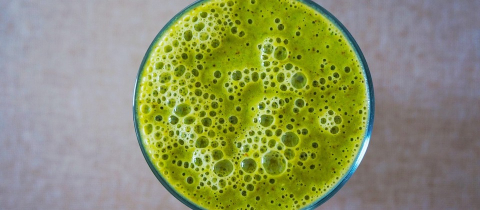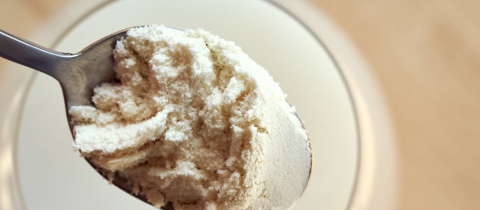Just like the omnipotence of the Wonderful Wizard of Oz was a mere illusion, so is the almightiness of chlorophyll water. From a distance, the emerald drink looks like an all-natural cure-all to clear up the skin, prevent cancer, and neutralize foul odours, but behind the curtain, we find a plant pigment whose might has grown in the telling. And while the wellness concoction does, appropriately enough, have ties to Dr. Oz, it is on TikTok, the short-video slot machine embraced by today’s youth, that it has gone viral.
As registered dietitian Abby Langer wrote while reporting on chlorophyll water, “TikTok is a cesspool of garbage nutrition videos.” It’s not just TikTok; any social media platform ends up serving up a five-course meal of food-based misinformation. By putting influencers front and center, these platforms end up empowering testimonials. Wellness anecdotes used to be exchanged during Tupperware parties when I was growing up. Now, they’re uploaded on TikTok but their reliability has not improved. Langer describes how these personal stories end up feeding very predictable wellness trends. First, a celebrity testifies to the power of some new healthy shiny thing. Their followers, for fear of missing out, jump on the rapidly forming bandwagon. Claims about what the new shiny thing can do are multiplied until it becomes a panacea. Eventually, the trend dies down as its routine intake proves too difficult to sustain and its results don’t live up to the hype. Soon enough, a new trend emerges and the cycle begins again.
On Instagram, where a quarter of a million posts have used the hashtag #chlorophyll, chlorophyll water and chlorophyll supplements are claimed to cleanse the blood and improve energy. They’re called “liquid sunshine” by some. On TikTok, the hashtag has garnered over 361 million views and teenagers are touting the product as a new acne medication.
What these young influencers may not know is that their grandparents fell for the same hype all the way back in the pre-Internet days of the 1950s.
A wicked pack of cigarettes
The history of how chlorophyll became in vogue was recently summarized by Dr. Sydnee McElroy on Sawbones, the medical podcast she co-hosts with her husband, and it shows how one generation’s debunked fad can be resurrected decades later to appeal to the next one.
Chlorophyll is a plant pigment which absorbs light and reflects green, giving plants their distinct colour. It is also a key molecule in photosynthesis, which is the process by which plants and other organisms capable of it convert CO2 and water into oxygen and sugar. This is all wonderful news for our lungs, which need oxygen to keep us alive, but in the 1930s, Dr. Benjamin Gruskin was curious to know if chlorophyll had other applications to human health. A nonprofit foundation bankrolled his research in exchange for the right to patent any resulting application. There were no major discoveries but the method that Dr. Gruskin used to dissolve chlorophyll in water was patented.
A few years later, an advertising executive convinced the nonprofit foundation to give him sole licensing rights on this patent. His business, called Rystan, used the patent to market a chlorophyll toothpaste in 1948. Meanwhile, a researcher by the name of F. Howard Westcott conducted, shall we say, “sub-optimal” studies that convinced him that chlorophyll was a potent deodorizer. Since he did not want to infringe on the patent, he marketed solid chlorophyll tablets to prevent bad breath. A 1950 Reader’s Digest article on the deodorizing powers of chlorophyll convinced consumers to shell out some green for, well, another form of green. Store shelves were stocked with chlorophyll gums, toothpastes, soaps, and even cigarettes equipped with chlorophyll filters to allegedly block the noxious smell of smoking.
The chlorophyll fad did not last very long, but here we are, seventy years later, and it is in full bloom again. Chlorophyll is being crowned the Great Detoxifier, and while the word “detox” is largely a red flag for pseudoscience, there is one application of chlorophyll in this area that has some merit.
Tik-Tok of Oz
Aflatoxins are secreted by certain moulds and can end up contaminating food like cereals, spices, peanuts, as well as animal byproducts like milk, meat, and egg. The name “aflatoxin” actually comes from a contraction of the Latin name of one of the moulds that secrete it, Aspergillus flavus. Being exposed to aflatoxins has been strongly linked to a type of liver cancer known as hepatocellular carcinoma, particularly in parts of Africa and Asia where testing grain for the presence of aflatoxins is less common. Studies have provided good evidence that a form of chlorophyll taken three times a day seems to bind to the cancer-causing compounds created by aflatoxins in the human body. This could potentially prevent liver cancer, which is encouraging news especially for people typically exposed to aflatoxins through contaminated food and drink. However, studies in humans have not measured rates of cancer in people consuming the chlorophyll for years. Instead, they used a surrogate marker to infer that the chlorophyll was interfering with the formation of these carcinogens and the studies only lasted a few months.
A comprehensive review of the evidence on chlorophyll for human health was published in 2014, and apart from chlorophyll’s protective effect against aflatoxins (where the scientific evidence was graded as “good”), every claim looked at—from overall cancer prevention to reducing odours—received a “C” grade, meaning that the scientific evidence was unclear or conflicting. As a skin application to treat burns and wounds, there is theoretical evidence that chlorophyll might help in growing new tissue, but there is no reliable scientific evidence to back this up. To prevent cancer, it is possible that chlorophyll is one of many molecules in green vegetables that protect us from cancer, but the evidence for chlorophyll supplements to ward off cancer is unclear. As a deodorant for people with a colostomy bag, there is a lack of good evidence that it works. A doctor who had evaluated chlorophyll’s potential as a deodorizer during its boom in the 1950s was said to have observed that many animals, including goats, consume a lot of chlorophyll but “some of these animals are noted for their pungent aroma.” This was turned into a rhyme published at the time in the Wall Street Journal: “Why reeks the goat on yonder hill, who seems to dote on chlorophyll?” Sure, goats have not invented soap yet, but you would think all that chlorophyll would help with the smell!
Given this paucity of data, we may wonder why so many TikTokers swear by chlorophyll water when it comes to their skin. It may be as simple as drinking more fluid helps. It may be the effect of undisclosed medication. It may be time. Acne doesn’t last forever, and skin conditions can wax and wane. This is why anecdotes are not reliable. Studies of chlorophyll for skin conditions are not exactly breathtaking: a study on photoaging with no real control group; an industry-funded study with only five participants; and a study in which sheets of a chlorophyll-containing solution were applied to the skin to sensitize it to a light that could better treat acne, but in which there was, again, no control group.
Meanwhile, the claim made about chlorophyll increasing our oxygenation comes from the fact that the plant pigment strongly resembles heme, the molecule that binds oxygen in our red blood cells through the use of an atom of iron. But chlorophyll does not have iron; it has magnesium instead, and its role is not to transport oxygen but to absorb sunlight used for photosynthesis. So even this claim falls flat.
While supplementing with chlorophyll is likely to be safe, there are a few important caveats for those wishing to experiment with it despite the lack of evidence. The highest dose studied in clinical research seems to be a daily 300 mg of chlorophyllin, a water-soluble version of chlorophyll, for a four-month period. Beyond that, science is mute. When adding drops of chlorophyllin to a beverage, the consumer can control the dose they are ingesting, but in a pre-mixed product like Chlorophyll Water®, the exact amount of plant pigment being consumed does not appear to be disclosed. It is interesting to note that neither chlorophyll nor chlorophyllin appear on the Food and Drug Administration’s list of food additives generally recognized as safe (GRAS). The comprehensive review mentioned earlier points out a number of side effects reported in studies on the use of chlorophyll, from people becoming more sensitive to sunlight to some experiencing loose stools and skin irritation, as well as the possibility of chlorophyll supplements interacting with prescription medication. Be aware that it may turn your tongue yellow or black, and your urine and stool a bit green. Finally, given that chlorophyll is not a medical drug, the usual warning about possible adulteration or contamination prevails. The supplement industry is indeed a Wild West.
Chlorophyll water is simply the latest in a long line of wellness beverages that capitalize on the appeal to nature. You may remember the hype around wheatgrass juice, which was based in large part on the presence of chlorophyll. We’ve seen mushroom coffees, skinny teas, celery juice, and charcoal lattes. If we want to harness the benefits of the green, it’s much better (and cheaper) to simply eat more green vegetables. But this idea of “drinking nature,” of allowing one of Mother Earth’s gifts to detoxify us and restore our purity speaks to an ancient part of our brain we are unlikely to suppress anytime soon. The irony in this case is that the chlorophyll in chlorophyll water is not 100% natural. When the pigment is extracted from plants, it breaks down easily. To improve its stability and allow it to dissolve in water, scientists have to replace the magnesium it contains with a different element, usually copper. This is chlorophyllin, a semi-synthetic chemical, and that is the compound that gives chlorophyll water its green colour.
But if we don’t peek behind the science curtain and simply trust the hype, we may find ourselves hypnotized by the seemingly great and powerful emerald chlorophyll of Oz.
Take-home message:
-Drinking chlorophyll water is trending on the social media video platform TikTok, with users attributing many health claims to the concoction, including that it can help with skin conditions like acne
-The promotion of chlorophyll for improved health and well-being first trended in 1950, when it was prominently added to toothpastes, gums, and cigarettes
-Aside from offering some protection against aflatoxins in people exposed to them through the food supply, chlorophyll supplements have unclear or conflicting evidence behind them, and chlorophyll water can be seen as simply the latest trendy wellness beverage backed by unreliable anecdotes and not science
Leave a comment!







